The post How To Defend Yourself Using Only A Knife was originally published on Total Survival


 For thousands of years, knives have remained one of the most popular weapons for self-defense. Even today in the age of semi-automatic handguns that are easily concealed, many people still choose to carry a knife due to their convenience, safety, and lack of legal restrictions.
For thousands of years, knives have remained one of the most popular weapons for self-defense. Even today in the age of semi-automatic handguns that are easily concealed, many people still choose to carry a knife due to their convenience, safety, and lack of legal restrictions.
However, if you’re going to effectively defend yourself with a knife, there is plenty that you need to know. Here is a brief guide to using a knife for self-defense.
Want to save this post for later? Click Here to Pin It on Pinterest!
The Grim Realities of Defending Yourself With a Knife
Before start discussing how to defend yourself with a knife, it’s important to understand what knife self-defense is actually like in a real-world situation.
Defending yourself with a knife is brutal, grisly business. It’s nothing like the Hollywood portrayals where people are instantly incapacitated or killed by a single stab wound. Stopping a determined attacker using only a knife will most often mean stabbing and cutting them over and over again. Knives simply don’t inflict the same level of shock, trauma, and destruction that a gunshot wound does.
If you plan on carrying a knife as a means of self-defense, you must be psychologically prepared to use it. Otherwise, it’s a false sense of security at best and a weapon that could be turned against you at worst.
When it comes to knife fights, skill and tactics are certainly important, but speed, aggression, and determination are what wins the fight. It’s a grim reality, but if you don’t have it in you to plunge a blade into another human being over and over until the threat is neutralized, you’re better off finding another means of self-defense.
The Best Knives for Self Defense
The best knife for self-defense is going to be a knife that was designed for defense purposes. In a life and death fight, a small pen knife is not going to do you much good. In fact, many knife fighting experts say that you’re better off defending yourself using only hand-to-hand tactics than you are trying to defend yourself with a small folder that was never designed for self-defense. Again, this mostly goes back to the knife becoming more of a false sense of security than it is an effective weapon.
With that said, there are plenty of knives on the market that were designed for defense purposes, and they can be brutally effective in the right hands. Spyderco, Cold Steel, and KA-BAR are just a few companies that offer high-quality self-defense knives.
Self-defense knives can be designed for slashing, stabbing, or a combination of both. Typically, the better the knife is for stabbing, the worse it will be for slashing, and vise versa. For instance, the Cold Steel Ti-Lite is purely a stabbing instrument. Its straight, narrow blade is designed for quick stabbing attacks.
Meanwhile, knives such as the Cold Steel Black Talon or the Spyderco Civilian are designed almost entirely for slashing attacks.
In the end, one design isn’t necessarily better than the other. However, it is highly important to know what your knife was designed for in order to know the best way to use it.
How to Hold a Knife in a Self-Defense Scenario
The two most common ways to hold a knife are forward grip and reverse grip. We’ll discuss them below.
Forward Grip



When it comes to how you should grip a knife in a self-defense scenario, it’s best to keep it simple. Hold the knife in what’s known as a forward or traditional grip. For reference, a forward grip is the same grip you would use if you were cutting into a steak with a steak knife.
There are variations of the forward grip that differ in exactly where you place your fingers and thumb, and which one is best ultimately depends on your personal preference and the shape of your knife’s handle. Here are the most common:
- Saber Grip – Just like in the image above.
- Modified Saber Grip – Like the saber, but with your thumb on the side of the blade.
- Filipino Grip – Like the saber, except with your thumb on the spine of the knife back.
- Hammer Grip – Literally hold the knife the way you would a hammer.
If you place your fingers and thumb in the most intuitive, comfortable places possible, it should be easy enough to figure out the exact forward grip that will serve you best.
Reverse Grip



There’s really only one other way to grip a knife aside from a few bizarre, uncommon grips, and this is the reverse grip. In the reverse grip, your forearm and the blade of the knife form a ninety-degree angle.
There are only two types of reverse grips: edge in and edge out. Most people instinctively hold a knife with the edge in. It’s how bad guys always hold the knife in movies (think of the shower scene in Psycho).
However, having the edge out is more advantageous because, unless your arm is straight, the cutting edge is always facing your enemy.
There are some drawbacks to the reverse grip. It does not allow for strikes that are as swift and fluid as the strikes that the forward grip allows. The reverse grip does enable you to put a little more power behind your strikes, but that power comes at the cost of slowing down your attacks and telegraphing them to your opponent.
The reverse grip is also much less effective in extremely close quarters where you don’t have room to swing your knife with your arm fully extended whereas, with the forward grip, you can effectively stab and cut at an opponent that is just inches in front of you.
On Switching Grips Mid-Fight
Don’t do it. Switching grips mid-fight is a tactic best left to Hollywood actors unless you have an extraordinary amount of training. The last thing you want to do is accidentally drop your knife because you were trying to switch your grip.
Knife Self-Defense Tactics
Learning how to effectively fight with a knife has far less to do with the knife itself than you might realize. As with unarmed combat, much of the technique behind knife fighting involves footwork, spacing, and angles of attack.
If you want to start learning the tactics behind knife self-defense, it’s best to start with the footwork. Learn how to fluidly move in and out of attack range, circle an opponent, lunge forward and backward, and otherwise maneuver during the fight.
The footwork involved with knife fighting is much the same as the footwork involved with boxing, so taking a class in boxing or otherwise learning boxing footwork will greatly improve your knife fighting abilities. It will also help you learn range and spacing so that you will intuitively know whether or not your opponent is in striking distance.
Protecting your knife is another essential area of knife fighting. Having your attacker take your knife away from you and use it against you is an absolute worst-case scenario. You never want to leave your knife dangling out in front of you.
Remember, if your knife is within striking range of your opponent, the wrist of your knife hand is in range for them to grab. Once they have ahold of your wrist, fighting for control of the knife becomes a life and death struggle. Always keep your knife hand moving, keep your strikes swift, and stay out of range unless you are throwing strikes.
There are many other things that could be said about knife fighting tactics that go beyond the scope of this article. In the end, though, training in these tactics first-hand is going to be infinitely more valuable than reading about them.
Taking a class in boxing will teach you plenty of techniques that you can apply to knife fighting. Taking a class in knife fighting itself, of course, will be even more beneficial. If you are serious about learning how to defend yourself with a knife, there is no substitute for real-world training.
Defending Yourself With a Knife Against an Armed Opponent
The effectiveness of a knife against an armed opponent depends on a number of factors, the most important being what your opponent is armed with.
One of the most talked about scenarios is how a person with a knife fairs against a person with a gun. You may have heard before about the 21-foot rule. This rule was developed by a Salt Lake City Police Department firearms instructor, and it states that an attacker with a knife can close a distance of 21 feet before someone armed with a gun can neutralize the threat.
However, this rule makes a few critical assumptions. For one, it assumes that the person’s gun is holstered rather than drawn. It also assumes that the attacker with the knife has the initiative and the element of surprise. If you are up against someone who has already drawn their gun, there is no distance – or lack thereof – where you will have the advantage. Pulling a trigger is always going to be faster than any knife attack from any distance.
Against blunt force weapons such as baseball bat, knives fair a little better. If you have a knife and are up against someone who is armed with a bat, a crowbar, or any blunt force weapon, distance is your enemy. Blunt force weapons are useless in extremely close quarters where there is no room to swing the weapon at full extension.
Of course, getting in this close without taking an incapacitating blow is another matter. If they can close the distance, though, and get within a couple feet of their opponent, the person with the knife will have the advantage.
Going up against an attacker who is also armed with a knife is pure tossup. Understand that if you are fighting someone who has a knife, you are going to be cut and stabbed, probably multiple times. There are no winners in a knife duel – only those who barely survive and those who don’t.
Related: 11 Best Knives to Have in a Disaster (and Why)
Like this post? Don’t forget to Pin It on Pinterest!
This article first appeared on urbansurvivalsite.com See it herePost Source Here: How To Defend Yourself Using Only A Knife

No comments:
Post a Comment